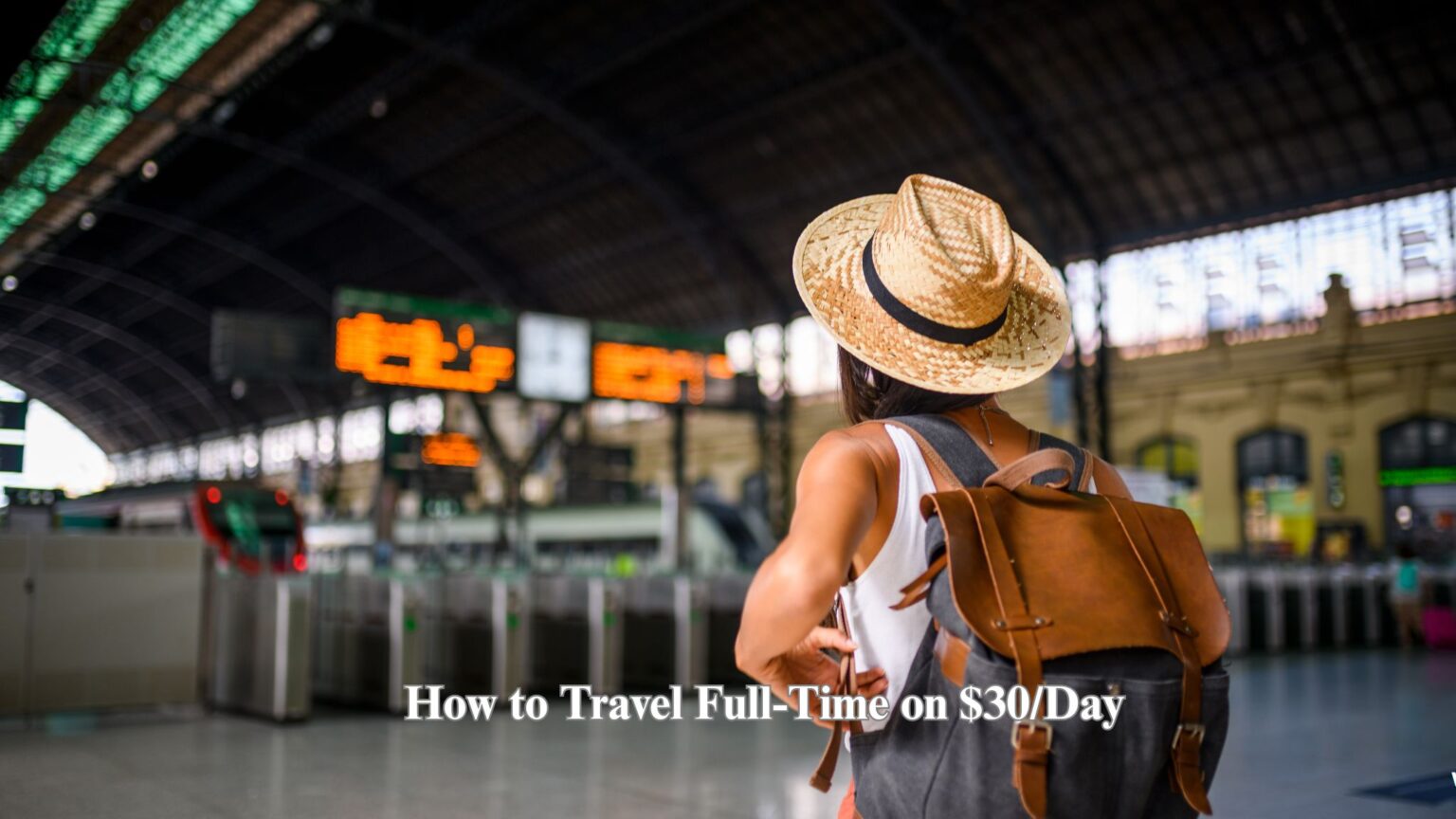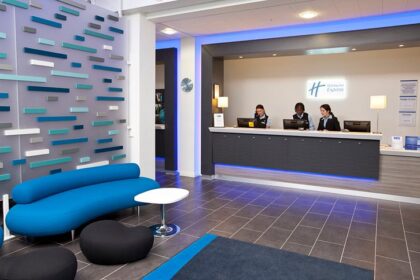After three years of full-time travel across 47 countries while working remotely as a freelance developer, I’ve cracked the code on sustainable budget travel that doesn’t sacrifice productivity, health, or happiness. Living on exactly $30 per day ($900/month, $10,950/year) has taken me through Southeast Asia, Eastern Europe, Central America, and parts of Africa while maintaining a six-figure income and building a thriving online business.
This isn’t about surviving on ramen noodles in hostels or sacrificing comfort for savings. It’s about understanding the real economics of global living costs, leveraging geographic arbitrage strategically, and building systems that make ultra-budget travel sustainable for years rather than weeks. The numbers I’ll share are from actual expense tracking over 36 months, including every coffee, visa fee, and emergency expense that reality throws at long-term travelers.
Most “budget travel” advice focuses on short-term backpacking or gap year adventures. But sustaining $30/day for years while running a business requires completely different strategies around housing, technology, healthcare, and lifestyle optimization. I’ve learned these lessons through trial, error, and countless spreadsheet adjustments across dramatically different cost-of-living environments.
The financial freedom this lifestyle provides isn’t just about saving money—it’s about geographic arbitrage that lets you live like royalty in some places while building wealth that provides security and options for the future. By the end of this guide, you’ll have the exact numbers, systems, and strategies that have made this possible for me.
The Real Math: Breaking Down $30/Day
Monthly Budget Breakdown
My $900 monthly budget splits across five core categories that I’ve optimized through three years of experimentation:
Housing: $300-400/month (33-44% of budget)
- Long-term accommodation rentals averaging $10-13/day
- Utilities and internet included in rental negotiations
- Strategic location selection for maximum value
Food: $150-200/month (17-22% of budget)
- Grocery shopping and home cooking: $100-120/month
- Strategic restaurant meals and local specialties: $50-80/month
- Protein supplements and health optimization: $20-30/month
Transportation: $100-150/month (11-17% of budget)
- Local transportation and daily mobility: $30-50/month
- Long-distance travel between countries/cities: $70-100/month
- Vehicle rentals for exploration: $0-50/month (occasional)
Technology and Communication: $80-120/month (9-13% of budget)
- Mobile internet and local SIM cards: $20-40/month
- Backup internet solutions and coworking: $30-50/month
- Equipment maintenance and replacements: $30-30/month
Healthcare and Insurance: $50-80/month (6-9% of budget)
- Travel insurance with global coverage: $45-65/month
- Local healthcare and preventive care: $5-15/month
Miscellaneous and Buffer: $50-100/month (6-11% of budget)
- Visa fees averaged over time: $20-40/month
- Entertainment and social activities: $15-30/month
- Emergency fund contributions: $15-30/month
Geographic Cost Variations
The $30/day average works because of dramatic cost variations between regions that I exploit through strategic movement and timing:
Ultra-Low Cost Regions ($18-25/day):
- Northern Vietnam: $22/day average
- Rural Guatemala: $19/day average
- Parts of Cambodia: $20/day average
- Eastern Ukraine (pre-conflict): $18/day average
Moderate Cost Regions ($25-35/day):
- Thailand outside Bangkok: $28/day average
- Czech Republic smaller cities: $32/day average
- Mexico outside tourist zones: $26/day average
- Parts of Eastern Europe: $30/day average
Higher Cost Regions ($35-45/day):
- Western Europe (strategic periods): $42/day average
- Tourist-heavy areas during off-seasons: $38/day average
- Major cities during specific events: $45/day average
The key insight is spending 70% of time in ultra-low and moderate cost regions, with strategic splurges in higher-cost areas during optimal timing or for specific business opportunities.
Housing: The Foundation of Budget Travel
Long-Term Rental Strategy
Short-term accommodations destroy budget travel faster than any other factor. Hotels, hostels, and even Airbnb nightly rates create costs that make $30/day impossible in most locations. My housing strategy focuses exclusively on monthly rentals that provide massive cost savings and productivity environments.
The 30-Day Minimum Rule: I never book accommodation for less than 30 days, and prefer 2-3 month commitments when possible. This simple rule typically reduces housing costs by 50-70% compared to nightly rates while providing stability for work routines.
In Chiang Mai, Thailand, I paid $280/month for a modern one-bedroom apartment with high-speed internet, gym access, and rooftop pool—the equivalent nightly Airbnb rate was $35/night ($1,050/month). The same apartment cost different prices based on commitment length: $50/night for 1-7 nights, $35/night for 8-29 nights, $280/month for 30+ nights.
The Direct Contact Approach: Platforms like Airbnb, Booking.com, and others add 15-25% in fees that disappear when dealing directly with property owners. After initial contact through platforms, I negotiate longer-term rates through direct communication, often saving an additional 20-30%.
Location Optimization Within Cities: Prime downtown areas cost 3-5x more than locations 15-20 minutes from city centers via public transportation. I choose neighborhoods that provide easy access to coworking spaces, markets, and transportation while avoiding tourist density that drives up prices.
Negotiation and Relationship Building
Property owners in most countries prefer long-term tenants who pay on time, communicate clearly, and maintain properties well. These preferences create negotiation opportunities that short-term travelers can’t access.
The Professional Tenant Approach: I present myself as a remote professional who values quiet, clean environments for work. I provide references from previous landlords, demonstrate financial stability, and explain my work requirements. This positioning often results in preferential treatment and pricing.
Seasonal Timing Advantages: Rental markets have predictable seasonal patterns that create pricing opportunities. Tourist-dependent areas have dramatically lower prices during off-seasons, while business districts have lower prices during vacation periods.
Relationship Investment: I invest in relationships with property managers and owners who can provide future accommodations or referrals. This network has provided access to properties that aren’t advertised publicly and pricing that reflects relationship value rather than market rates.
Accommodation Quality and Productivity
Budget accommodation doesn’t mean sacrificing productivity or comfort. I’ve developed standards that ensure work capability while maintaining cost targets:
Internet Requirements: Minimum 25Mbps download speed with backup options nearby. Internet quality affects income potential more than any other factor. I test internet speeds during property visits and negotiate backup solutions when primary connections are unreliable.
Workspace Optimization: Dedicated work area with ergonomic seating and proper lighting. Many budget accommodations lack proper work environments, but simple additions like ergonomic cushions, desk lamps, and monitor stands create productive spaces for under $50.
Kitchen Access: Full kitchen facilities reduce food costs by 60-80% compared to restaurant dining. Kitchen access is non-negotiable because food costs explode without cooking capability.
Location Logistics: Walking distance to markets, transportation, and backup internet sources. Remote locations with lower rent become expensive when transportation costs and time losses are calculated.
Food: Eating Well for $5-7/Day
The 80/20 Cooking Strategy
Restaurant meals in any country cost 3-10x more than home cooking for equivalent nutrition and quality. My food budget assumes 80% home-cooked meals and 20% strategic restaurant experiences that provide cultural value or business opportunities.
Market Shopping Optimization: Local markets provide fresh ingredients at prices that would shock Western travelers. In Vietnam, I spent $15/week on market vegetables, fruits, and proteins that would cost $80+ in US grocery stores. Learning market shopping requires language basics and cultural understanding, but provides enormous cost advantages.
Bulk Staple Purchasing: Rice, beans, lentils, oats, and other staples cost pennies per serving when purchased in bulk. I maintain supplies of 5-10 staple ingredients that provide nutritional foundations for endless meal variations.
Protein Cost Management: Protein typically represents 40-60% of food costs globally. I optimize protein through local options (fish in coastal areas, chicken in agricultural regions), plant-based alternatives, and strategic purchasing during market price cycles.
Cooking Equipment Investment: Quality portable cooking equipment pays for itself within weeks. A good chef’s knife ($40), cutting board ($15), and basic seasoning collection ($30) transform any kitchen into a productive cooking environment.
Nutritional Optimization on Budget
Maintaining health during long-term budget travel requires systematic attention to nutrition that goes beyond just minimizing costs:
Micronutrient Tracking: Budget diets often lack micronutrients that affect energy, mood, and cognitive performance. I supplement strategically with vitamins D, B12, and omega-3s that are difficult to obtain through budget diets in many countries.
Protein Adequacy: Maintaining muscle mass and energy requires adequate protein intake that budget travelers often sacrifice for carbohydrate-heavy diets. I target 1g protein per kg body weight through strategic protein source selection.
Local Superfood Integration: Every region has nutrient-dense local foods that provide exceptional value. Coconuts in Southeast Asia, avocados in Central America, and organ meats in Eastern Europe provide premium nutrition at budget prices.
Meal Preparation Efficiency: Batch cooking and meal prep reduce both costs and time investment in food preparation. I cook 2-3 times per week in large quantities, freezing or refrigerating portions for quick daily meals.
Strategic Restaurant Experiences
The 20% restaurant portion of my food budget focuses on experiences that provide cultural, social, or business value rather than just convenience:
Local Specialty Experiences: Each destination has signature dishes that provide cultural understanding and memorable experiences. I budget $20-30/month for trying local specialties that would be impossible to recreate through home cooking.
Business Meeting Venues: Restaurant meals that serve business purposes—client meetings, networking events, or workspace alternatives—provide value beyond food costs. These strategic meals often generate income that far exceeds their cost.
Social Integration Opportunities: Sharing meals with locals, other nomads, or business contacts creates relationship-building opportunities that have professional and personal value.
Market Research and Learning: Restaurant meals provide education about local ingredients, cooking techniques, and flavor profiles that improve my home cooking and cultural understanding.
Transportation: Movement Strategy
Regional Transportation Optimization
Transportation costs vary dramatically based on distance, timing, and booking strategies. My approach focuses on optimizing these variables rather than always choosing the cheapest options:
Overland vs. Flight Economics: Flights often cost less than overland transportation for longer distances, but timing flexibility affects pricing dramatically. I book flights 2-6 weeks in advance during off-peak seasons, but use overland transportation for shorter distances and flexible timing.
Local Transportation Integration: Many cities have monthly transportation passes that cost less than daily tickets after 10-15 uses. I purchase monthly passes immediately upon arrival in cities where I’ll spend extended time.
Regional Pass Strategies: Some regions offer transportation passes that provide unlimited travel for specific periods. European train passes, Southeast Asian bus passes, and regional airline passes can provide significant savings for travelers with flexible itineraries.
Slow Travel Economics
Moving frequently destroys budget travel through transportation costs, accommodation booking fees, and productivity losses during travel days. Slow travel provides multiple economic advantages:
Transportation Cost Amortization: Staying in locations for 2-3 months amortizes transportation costs over longer periods, reducing per-day transportation expenses.
Accommodation Booking Efficiency: Longer stays eliminate repeated booking fees, security deposits, and setup costs that accumulate through frequent moves.
Productivity Maintenance: Travel days are typically zero-productivity days that represent lost income for digital nomads. Minimizing travel frequency maintains higher productivity levels and income potential.
Relationship and Network Development: Staying in locations longer enables deeper relationship building with locals, other expats, and business contacts that provide ongoing value.
Transportation Booking Strategies
Flexible Date Advantages: Maintaining flexible travel dates enables significant transportation savings through optimal pricing timing. Flight prices can vary by 50-200% based on date flexibility.
Off-Peak Season Planning: Traveling during off-peak seasons provides lower transportation costs and accommodation prices, but requires planning around weather patterns and local event schedules.
Regional Carrier Optimization: Local and regional transportation companies often provide better prices than international brands, but require local knowledge and booking capabilities.
Ground Transportation Networks: Developing relationships with reliable local drivers for longer-distance ground transportation often provides better value and flexibility than commercial transportation options.
READ ALSO: The Pickpocket Techniques I’ve Seen in 50+ Countries (And How to Beat Them)
Technology: Staying Connected and Productive
Internet and Communication Strategy
Reliable internet access affects income potential more than any other factor for digital nomads. My technology budget prioritizes redundancy and reliability over cost minimization:
Primary and Backup Internet: I maintain 2-3 internet sources in every location: accommodation WiFi, local SIM card with data plan, and backup option (coworking space membership, internet café access, or secondary SIM card).
Local SIM Card Optimization: Local SIM cards provide data at prices that would shock travelers relying on international roaming. In most countries, unlimited data plans cost $10-30/month compared to $10-20/day for international roaming.
Coworking Space Strategy: Coworking spaces provide reliable internet, professional environments, and networking opportunities. Day passes ($5-15) or monthly memberships ($50-150) often provide better value than upgrading accommodation for internet reliability.
Equipment Redundancy: Critical equipment failures can destroy income for weeks while waiting for replacements. I carry backup power adapters, charging cables, and mobile hotspot devices that enable continued productivity during equipment failures.
Equipment Minimization and Optimization
Carrying minimal equipment reduces transportation costs, accommodation constraints, and replacement expenses while maintaining full productivity capability:
Single Device Strategy: High-quality laptop that handles all work requirements eliminates need for tablets, desktop computers, or specialized equipment. I use a 13-inch MacBook Pro that provides professional capability in minimal size and weight.
Universal Equipment Selection: Power adapters, charging cables, and accessories that work globally eliminate need for region-specific equipment and reduce carrying weight.
Cloud-First Workflow: Cloud-based tools and storage eliminate dependence on physical equipment and enable productivity from any device with internet access.
Repair and Replacement Networks: Developing relationships with equipment repair and replacement sources in major nomad destinations enables quick resolution of equipment problems.
Productivity and Business Tool Costs
Business tools and software represent ongoing costs that must be balanced against productivity and income benefits:
Essential Software Subscriptions: Adobe Creative Suite ($50/month), development tools ($20/month), and productivity software ($15/month) provide income-generating capability that justifies their costs.
Communication and Collaboration Tools: Video conferencing, project management, and client communication tools ($30/month total) enable professional client relationships and team collaboration.
Backup and Security Services: Cloud backup ($10/month) and VPN services ($5/month) provide security and data protection that prevents catastrophic business losses.
Financial and Administrative Tools: Accounting software, payment processing, and business management tools ($25/month total) enable professional business operations from anywhere globally.
Healthcare: Staying Healthy on Budget
Travel Insurance Strategy
Healthcare costs can destroy budget travel instantly without proper insurance coverage. My insurance strategy provides comprehensive global coverage while minimizing premium costs:
Annual Comprehensive Coverage: World Nomads or similar travel insurance provides global coverage for $540-780/year ($45-65/month) including emergency evacuation, routine healthcare, and equipment coverage.
Regional Healthcare Optimization: Many countries provide high-quality healthcare at prices that would shock Americans. Routine dental care in Eastern Europe costs 80% less than US prices while maintaining equivalent quality.
Preventive Care Investment: Investing in preventive healthcare prevents expensive emergency treatments. Annual checkups, dental cleanings, and health screenings cost $100-200 in most countries but prevent expensive problems.
Local Healthcare Navigation: Learning local healthcare systems enables access to quality care at local prices rather than tourist-targeted pricing.
Fitness and Wellness Maintenance
Maintaining physical and mental health during long-term travel requires systematic attention that budget travelers often neglect:
Bodyweight Exercise Systems: Gym memberships cost $20-50/month globally, but bodyweight exercise routines require no equipment and maintain fitness anywhere.
Nutrition Supplementation: Budget diets often lack micronutrients that affect energy and mood. Strategic supplementation costs $20-30/month but provides energy and health benefits worth far more.
Mental Health Resources: Isolation and cultural stress affect long-term travelers. Online therapy ($100-200/month) and meditation apps ($10/month) provide mental health support anywhere globally.
Activity Integration: Incorporating walking, hiking, swimming, and local activities into daily routines provides fitness and cultural experiences without additional costs.
Emergency and Crisis Preparation
Medical emergencies, equipment failures, and other crises can destroy budgets without proper preparation:
Emergency Fund Maintenance: $2,000-3,000 emergency fund enables handling of medical emergencies, equipment replacement, and emergency evacuation without borrowing or crowdfunding.
Documentation and Records: Medical records, prescription information, and emergency contact details stored in multiple accessible formats enable proper healthcare during emergencies.
Communication Networks: Maintaining communication with family, friends, and professional contacts enables support coordination during emergencies.
Local Emergency Resources: Understanding local emergency services, hospital locations, and evacuation procedures in each destination.
Country-Specific Cost Breakdowns
Southeast Asia: The Gold Standard
Southeast Asia provides the optimal combination of low costs, good infrastructure, and nomad-friendly environments:
Thailand Daily Breakdown ($28/day average):
- Housing: Modern apartment with pool and gym – $280/month ($9.33/day)
- Food: Market shopping and occasional restaurants – $150/month ($5/day)
- Transportation: Scooter rental and local transport – $60/month ($2/day)
- Internet: Unlimited data SIM + backup – $30/month ($1/day)
- Healthcare: Insurance + local care – $60/month ($2/day)
- Miscellaneous: Visas, entertainment, buffer – $250/month ($8.33/day)
Vietnam Daily Breakdown ($22/day average):
- Housing: Local apartment in expat area – $220/month ($7.33/day)
- Food: Heavy market cooking, minimal restaurants – $120/month ($4/day)
- Transportation: Motorbike and public transport – $40/month ($1.33/day)
- Internet: Local SIM unlimited data – $15/month ($0.50/day)
- Healthcare: Basic insurance + local care – $45/month ($1.50/day)
- Miscellaneous: Visa runs, activities, buffer – $220/month ($7.33/day)
Eastern Europe: Developed Infrastructure, Low Costs
Eastern Europe provides European infrastructure and culture at developing world prices:
Czech Republic Daily Breakdown ($32/day average):
- Housing: One-bedroom outside Prague center – $400/month ($13.33/day)
- Food: Grocery shopping with restaurant meals – $180/month ($6/day)
- Transportation: Public transport passes + occasional taxi – $80/month ($2.67/day)
- Internet: High-speed fiber + mobile backup – $40/month ($1.33/day)
- Healthcare: EU travel insurance + local care – $70/month ($2.33/day)
- Miscellaneous: EU travel, entertainment, buffer – $190/month ($6.33/day)
Ukraine Daily Breakdown (Pre-conflict – $18/day average):
- Housing: Modern apartment in Kyiv outskirts – $250/month ($8.33/day)
- Food: Market shopping, occasional dining – $100/month ($3.33/day)
- Transportation: Metro passes, occasional taxi – $30/month ($1/day)
- Internet: Fiber internet + unlimited mobile – $20/month ($0.67/day)
- Healthcare: Local insurance + private care – $40/month ($1.33/day)
- Miscellaneous: Visas, activities, savings – $100/month ($3.33/day)
Central America: Cultural Richness, Variable Costs
Central America provides cultural diversity and natural beauty with moderate costs and some infrastructure challenges:
Guatemala Daily Breakdown ($19/day average):
- Housing: Local apartment with basic amenities – $180/month ($6/day)
- Food: Market-heavy diet, local specialties – $90/month ($3/day)
- Transportation: Chicken buses, occasional shuttle – $45/month ($1.50/day)
- Internet: Multiple SIM cards for coverage – $35/month ($1.17/day)
- Healthcare: Regional insurance + local clinics – $50/month ($1.67/day)
- Miscellaneous: Border runs, activities, emergency fund – $170/month ($5.67/day)
Income Requirements and Optimization
Minimum Viable Income
Living on $30/day requires $10,950/year plus taxes, business expenses, and emergency funds. My recommended minimum viable income targets:
$20,000/year gross income minimum provides:
- $10,950/year living expenses
- $2,000/year tax allocation
- $2,000/year business expenses (equipment, software, marketing)
- $2,000/year emergency fund and savings
- $3,000/year buffer for higher-cost periods and opportunities
Income diversification strategy reduces risk from client loss or market changes:
- Primary client/service: 60% of income
- Secondary income streams: 30% of income
- Passive or semi-passive income: 10% of income
Geographic Arbitrage Maximization
The key to budget nomad success is maximizing the income/cost-of-living ratio through strategic location selection:
High-Income Work, Low-Cost Locations: Performing Western-priced services while living in developing world locations creates massive arbitrage opportunities.
Client Time Zone Management: Maintaining clients in higher-paying time zones while living in lower-cost regions requires careful schedule management but provides optimal arbitrage.
Skill Development Investment: Investing time and money in skills that command premium pricing enables maintaining income while reducing living costs.
Market Access Optimization: Some locations provide better access to specific markets or opportunities that can increase income beyond geographical arbitrage benefits.
Business Expense Optimization
Business expenses must be carefully managed within overall budget constraints:
Equipment Depreciation Planning: Laptop replacement every 3-4 years requires saving $500/year ($42/month) for equipment upgrades.
Professional Development Investment: Courses, certifications, and skill development typically cost $500-1,000/year but enable income growth that justifies the investment.
Marketing and Client Acquisition: Website hosting, portfolio maintenance, and client acquisition activities cost $200-500/year but enable business growth.
Legal and Financial Management: Business registration, accounting services, and tax preparation cost $300-800/year depending on business complexity and location.
Common Pitfalls and How to Avoid Them
The Penny-Wise, Pound-Foolish Trap
Many budget travelers optimize small expenses while ignoring large ones, creating false economy that actually increases costs:
Accommodation False Economy: Choosing cheaper accommodation without internet, kitchen, or workspace capabilities often increases total costs through productivity losses, restaurant meals, and coworking space requirements.
Transportation Optimization Mistakes: Always choosing cheapest transportation options without considering time costs, productivity losses, and arrival/departure timing can actually increase total trip costs.
Equipment Underinvestment: Buying cheap equipment that fails frequently costs more than investing in quality equipment that lasts years and maintains productivity.
Healthcare Gambling: Skipping insurance or preventive care to save money can result in catastrophic expenses that destroy years of careful budgeting.
The Social Isolation Problem
Extreme budget travel can lead to social isolation that affects mental health and business opportunities:
Social Activity Budget: Allocating $50-100/month for social activities, networking events, and relationship building provides value beyond entertainment.
Coworking and Community Investment: Spending on coworking spaces and nomad community activities creates professional and personal networks that provide long-term value.
Cultural Experience Balance: Avoiding all cultural activities and experiences to save money reduces the value and purpose of traveling.
Professional Networking: Investing in business networking, conferences, and professional development maintains career growth and income potential.
The Sustainability Challenge
Ultra-budget travel can become unsustainable without proper attention to long-term factors:
Burnout Prevention: Maintaining social connections, hobbies, and non-work activities prevents burnout that can destroy productivity and income.
Health Investment: Preventive healthcare, fitness, and wellness investments prevent expensive problems and maintain long-term capability for nomad lifestyle.
Emergency Fund Discipline: Maintaining emergency funds despite temptation to use them for travel or experiences ensures capability to handle crises.
Income Growth Planning: Focusing only on expense minimization without income growth planning limits long-term sustainability and opportunities.
Scaling Up: What Changes at Higher Budgets
The $50/Day Lifestyle Enhancement
Doubling the budget to $50/day ($1,500/month) provides disproportionate lifestyle improvements:
Housing Upgrades: $600-700/month housing budget enables luxury apartments, prime locations, and premium amenities that significantly improve productivity and comfort.
Transportation Freedom: Higher transportation budget enables optimal flight timing, ground transportation flexibility, and exploration opportunities.
Social and Business Opportunities: Increased restaurant and entertainment budget enables better networking, client entertainment, and cultural experiences.
Health and Wellness Premium: Budget for premium healthcare, fitness facilities, and wellness services maintains peak performance and prevents problems.
The $100/Day Professional Nomad
At $100/day ($3,000/month), nomad lifestyle becomes comparable to high-quality Western living standards:
Premium Accommodation: Luxury apartments, hotel suites, or premium co-living spaces with full amenities and services.
Business Class Travel: Comfortable transportation, optimal timing, and productive travel experiences.
Professional Services: Access to premium healthcare, financial services, legal support, and business services anywhere globally.
Investment and Savings: Substantial savings and investment capability while maintaining premium lifestyle.
Long-Term Sustainability and Exit Planning
The 3-Year Planning Cycle
Ultra-budget nomad lifestyle works best as 2-5 year strategy rather than permanent lifestyle:
Year 1: Learning and Optimization: Understanding systems, making mistakes, optimizing processes and budgets.
Year 2-3: Mastery and Accumulation: Maximizing arbitrage benefits, building savings, developing skills and income.
Year 4-5: Transition Planning: Preparing for next life phase, whether continued nomadism at higher budget levels, geographic settling, or career transitions.
Wealth Building Through Arbitrage
Living on $30/day while earning Western incomes creates massive wealth-building opportunities:
Savings Rate Optimization: Living on $11,000/year while earning $30,000+ enables 60-70% savings rates that accelerate financial independence.
Investment Opportunity: Geographic arbitrage provides capital for investments, business development, or real estate acquisition.
Skill Development Time: Lower living costs provide freedom to invest time in skill development, education, and business building that increases long-term income potential.
Network and Experience Value: International experience, cultural knowledge, and global networks provide career and business value that persists beyond nomad lifestyle.
Exit Strategy Planning
Successful budget nomadism requires planning for eventual transition to different lifestyle phases:
Location Independence Maintenance: Building careers and income sources that remain viable regardless of future location choices.
Relationship and Family Considerations: Planning for how nomad lifestyle integrates with long-term relationship and family goals.
Health and Aging Factors: Acknowledging that nomad lifestyle may become less sustainable with age or health changes.
Financial Independence Goals: Using nomad arbitrage period to build wealth that provides future lifestyle options and security.
Conclusion: The Real Value of $30/Day Nomadism
Living as a digital nomad on $30/day isn’t about extreme frugality or sacrificing quality of life. It’s about understanding global economics, optimizing for value rather than cost, and leveraging geographic arbitrage to build wealth while experiencing the world.
The financial discipline required to maintain this budget creates systems and habits that provide lifelong value. Learning to distinguish between needs and wants, optimize major expense categories, and find value in experiences rather than possessions provides benefits that extend far beyond the nomad lifestyle period.
The cultural experiences, language skills, adaptability, and global perspectives gained through extended international living provide personal and professional value that money cannot buy. These experiences create competitive advantages, business opportunities, and personal satisfaction that justify the effort required to make ultra-budget nomadism work.
Most importantly, proving to yourself that you can live comfortably anywhere in the world for $30/day provides psychological freedom that eliminates fear-based financial decisions. Knowing that you can reduce expenses to minimal levels if necessary enables taking entrepreneurial risks, pursuing passion projects, and making life decisions based on values rather than financial anxiety.
The three years I spent perfecting this lifestyle provided the foundation for everything I’ve built since. The savings enabled business investments, the experiences provided global market knowledge, and the skills developed during that period continue generating income years later.
This lifestyle isn’t for everyone, and it doesn’t need to be permanent. But for the right person at the right life stage, it provides an opportunity to see the world, build wealth, develop skills, and gain experiences that create lifelong value. The systems and strategies I’ve shared provide a roadmap for anyone ready to pursue this path.
Start with shorter trips to test systems and preferences, build gradually toward longer commitments, and always remember that the goal is creating value and experiences, not just minimizing costs. When done correctly, $30/day nomadism provides luxury lifestyle at budget prices while building wealth and capabilities for whatever comes next.
In another related article, The Airport Lounge Hack That Saves Me $3,000+ Per Year







